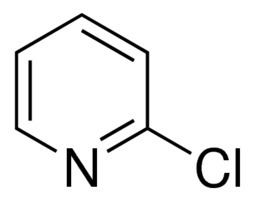Formula C5H4ClN | Molar mass 113.54 g/mol Appearance colorless liquid | |
 | ||
2-Chloropyridine is an organohalide with the formula C5H4ClN. It is a colorless liquid that is mainly used to generate fungicides and insecticides in industry. It also serves to generate antihistamines and antiarrythymics for pharmaceutical purposes.
Contents
Preparation
2-Choropyridine was originally described in 1898 by the chlorination of 2-hydroxypyridine. A typical chlorinating agent is phosphoryl chloride. It can also be generated by halogenating pyridine. This reaction affords a mixture of 2-chloro and 2,6-dichloropyridine.
Alternatively, 2-chloropyridines can be conveniently synthesized in high yields from pyridine-N-oxides.
Structure and properties
2-Chloropyridine reacts with nucleophiles to generate pyridine derivatives substituted at the second and fourth carbons on the heterocycle. Therefore, many reactions using 2-chloropyridine generate mixtures of products which require further workup to isolate the desired isomer.
Main reactions and applications
2-chloropyridine is primarily used to generate other pyridine derivatives. Some commercial products include pyrithione, pyripropoxyfen, chlorphenamine, and disopyramide. These reactions rely on chloride’s nature as a good leaving group to facilitate the transfer of a substrate onto the pyridine ring. Pyrithione, the conjugate base of 2-mercaptopyridine-N-oxide, is a fungicide found in some shampoos. It is generated from 2-chloropyridine by reacting the N-oxide of 2-chloropyridine with Na2S in a basic solution, before adding aqueous HCl. Used as an antihistamine, pheniramine may be generated via several different pathways. One synthesis is to hydroformylate functionalized olefins. This reaction proceeds by reacting phenylacetonitrile with 2-chloropyridine in the presence of a base. The resulting intermediate is then alkylated by 2-(dimethylamino)ethyl chloride and the cyano group removed.
Environmental Properties
Though pyridine is an excellent source of carbon, nitrogen, and energy for certain microorganisms, introduction of a halogen moiety significantly retards degradation of the pyridine ring. With the exception of 4-chloropyridine, each of the mono- and di-substituted chloropyridines were found to be relatively resistant to microbiological degradation in soil or liquid media. Estimated time for complete degradation was > 30 days. 2-Chloropyridine exhibits extensive volatilization losses from water, less so when present in soil.
